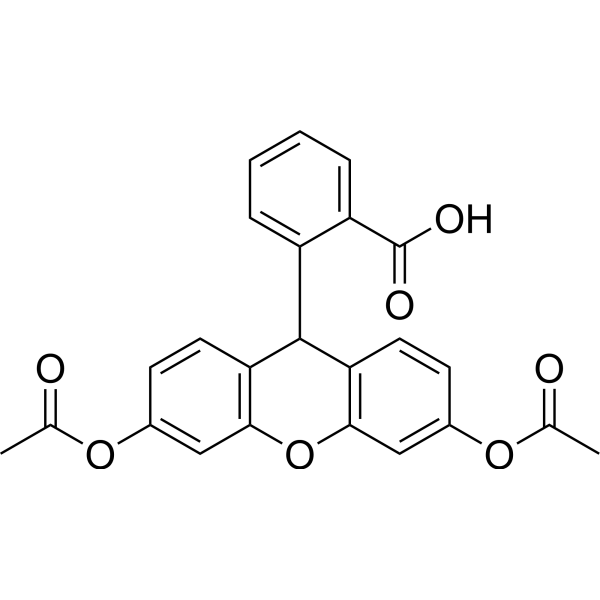
Dihydrofluorescein diacetate
CAS No. 35340-49-9
Dihydrofluorescein diacetate( Diacetyldihydrofluorescein )
Catalog No. M27035 CAS No. 35340-49-9
Dihydrofluorescein diacetate is a fluorescent probe for measuring oxidative stress in cell-free systems and cellular models.
Purity : >98% (HPLC)
 COA
COA
 Datasheet
Datasheet
 HNMR
HNMR
 HPLC
HPLC
 MSDS
MSDS
 Handing Instructions
Handing Instructions
| Size | Price / USD | Stock | Quantity |
| 50MG | 51 | In Stock |


|
| 100MG | Get Quote | In Stock |


|
| 200MG | Get Quote | In Stock |


|
| 500MG | Get Quote | In Stock |


|
| 1G | Get Quote | In Stock |


|
Biological Information
-
Product NameDihydrofluorescein diacetate
-
NoteResearch use only, not for human use.
-
Brief DescriptionDihydrofluorescein diacetate is a fluorescent probe for measuring oxidative stress in cell-free systems and cellular models.
-
DescriptionDihydrofluorescein diacetate is a fluorescent probe for measuring oxidative stress in cell-free systems and cellular models.(In Vitro):Dihydrofluorescein diacetate is able to detect the presence of ROS in mitochondria. Dihydrofluorescein diacetate fluorescence sharply delineates filaments that correspond in all detail to TMRM-stained mitochondria. It enters mitochondria and reacts with ROS released in the matrix. Dihydrofluorescein diacetate may be a useful quantitative method to measure the oxidation potential of nanoparticle-treated cells. Dihydrofluorescein diacetate shows fluorescence of linear structures, consistent with mitochondria, in reoxygenated endothelium.
-
In VitroDihydrofluorescein diacetate may be a superior fluorescent probe for many cell-based studies. It is a better fluorescent probe for detecting intracellular oxidants because it is more reactive toward specific oxidizing species. Dihydrofluorescein diacetate demonstrates fluorescence of linear structures, consistent with mitochondria, in reoxygenated endothelium. Dihydrofluorescein diacetate is able to detect the presence of ROS in mitochondria. Dihydrofluorescein diacetate fluorescence was sharp and delineated thin filaments which corresponded in all details to TMRM-stained mitochondria. It enters mitochondria and reacts with ROS released in the matrix. Dihydrofluorescein diacetate could be an useful and quantitative method for measuring the oxidative potential of nanoparticle-treated cells.
-
In Vivo——
-
SynonymsDiacetyldihydrofluorescein
-
PathwayOthers
-
TargetOther Targets
-
RecptorS1P
-
Research Area——
-
Indication——
Chemical Information
-
CAS Number35340-49-9
-
Formula Weight418.401
-
Molecular FormulaC24H18O7
-
Purity>98% (HPLC)
-
SolubilityIn Vitro:?DMSO : ≥ 106.5 mg/mL (254.54 )
-
SMILESCC(=O)Oc1ccc2C(c3ccc(OC(C)=O)cc3Oc2c1)c1ccccc1C(O)=O
-
Chemical Name——
Shipping & Storage Information
-
Storage(-20℃)
-
ShippingWith Ice Pack
-
Stability≥ 2 years
Reference
1.Lee H, et al. 4-Deoxypyridoxine improves the viability of isolated pancreatic islets ex vivo. Islets. 2013 May-Jun;5(3):116-21.
molnova catalog



related products
-
Gracillin
Gracillin can induce cell cycle arrest, oxidative stress, and apoptosis in HL60 cells, and has the potential to be developed as an antitumor agent.
-
GSK3 Peptide Substra...
GSK3 Peptide Substrate
-
Tyr-PDGF A-Chain (19...
Tyr-PDGF A-Chain (194-211)



 Cart
Cart
 sales@molnova.com
sales@molnova.com


